Amazon
Strategies to Optimize Your Amazon PPC Campaigns

Amazon PPC has proven to be an effective channel for advertisers looking to drive sales and visibility. However, with so many different factors to consider and strategies to implement, optimizing your PPC campaigns can be challenging. That’s why we’ve compiled this helpful blog post on Amazon PPC best practices and strategies for success. If you’re just getting started with Amazon or are looking for ways to boost performance of your current campaigns, read on to learn about the ins and outs of Amazon sponsored ads.
What Is Amazon PPC?
PPC stands for “pay per click,” which refers to an advertising model where advertisers pay for each click on their ads. Amazon’s PPC platform is one of the most popular and effective advertising channels for sellers looking to build brand awareness and generate sales.
On Amazon, PPC ads allow sellers to create sponsored product or sponsored brand ads that show up in search results and on product detail pages. Showing up in search results and the product detail page are the 2 places where sellers can get the most visibility and drive sales. When you create PPC ads on Amazon, you bid on keywords and pay for clicks on your ad.
The more you bid, the more frequently your ad shows up and the more you’ll pay for clicks on your ad.
Why Should You Use Amazon PPC?
Amazon PPC is an effective channel for driving sales and increasing brand visibility. According to a study by Oracle, 85% of Amazon customers start their product searches on the Amazon search engine. That means that when customers are looking for products to buy, the most likely place for them to start is Amazon.
Amazon PPC ads are great for reaching target audiences and driving traffic to your product listing. They’re also relatively inexpensive and easy to set up. With Amazon PPC, you can target potential customers based on many different factors, including their location, browsing and shopping patterns, and even their current mood. Keep in mind, though, that while PPC is a great way to drive sales, it’s not designed to replace SEO. You should view PPC as an added bonus to SEO and use both channels to their full potential.
Key best practices for Amazon PPC
Know your goals and what you’re trying to achieve: This is the most important step for creating a successful PPC campaign. Before you even get started with setting up your campaign, know exactly what you’re trying to achieve with your ad spend. If you don’t, you’ll likely waste a ton of money and not make any profit.
Plan out your budget and ad schedule: once you know your goals, you need to figure out a budget for your PPC campaign and determine how often you want to run your ads. Keep in mind that although you can pause or stop your ads at any time, you won’t be able to recoup any money you’ve spent on ads that have yet to run.
Set specific goals for each ad group: once you’ve created your campaign, it’s time to create ad groups. An ad group is where you’ll create your ads. Remember, each ad group should have a specific goal or outcome that you’re trying to achieve, and the ads within that ad group should all be focused on that same outcome.
Use Negative keywords: negative keywords let you show up less frequently for irrelevant searches and prevent your ads from being shown to people who don’t actually want to buy your product. That’s why it’s important to include negative keywords in your campaign.
When to use Display Network Only Ads
Display Network Only ads are best used when you’re trying to drive traffic to your Amazon listing from outside of Amazon. They’re also an option if you want to show up for both Amazon and non-Amazon customers, but you don’t want to show up for non-Amazon customers on Amazon.
These ads don’t appear on Amazon, but they do appear on different sites and the Amazon mobile app. If you’re integrating your Amazon and non-Amazon advertising campaigns, consider using Display Network Only ads to drive more traffic to your Amazon listing. Keep in mind that you’ll need to create and manage two different advertisements, which may be more work. However, you’ll likely end up reaching a wider audience and increasing your ad spend.
How to use Sponsored product ads effectively
If you’re currently using or are planning to start using Amazon PPC, it’s important to keep these best practices in mind. Your ads will only be as successful as they are relevant and engaging. When it comes to sponsored product ads, these tips can help you create ads that resonate with customers.
Create highly targeted ads: one of the best ways to generate sales is to create ads that are highly targeted and relevant. Create ads that speak directly to your customers and resonate with them by leveraging information you’ve collected about your target audience.
Use high-quality images: The images you use in your ads are just as important as the text. Make sure your images are high-quality, eye-catching, and relevant to your product
Use compelling copy: Your copy should be compelling, easy to read, and written in a way that resonates with your target audience. Remember to use the same keywords and phrases you’ve used to target your audience throughout the rest of your Amazon PPC campaign.
Strategies to increase CTR for Amazon Sponsored Ads
You would need to use negative keywords Negative keywords let you show up less frequently for irrelevant searches and prevent your ads from being shown to people who don’t actually want to buy your product.
That’s why it’s important to include negative keywords in your campaign.
Create multiple ad variations: It’s not uncommon for sellers to create several ad variations and then let their Amazon PPC algorithm decide which ads show up for which keywords.
Set higher bids: If you’re not seeing any impressions or clicks on your ads, consider increasing your bids. However, keep in mind that if you set your bids too high, you could end up with a lot of wasted ad spend.
Conclusion
Amazon PPC is an effective and inexpensive way to reach potential customers and drive sales. Keep in mind that it’s not an alternative to SEO, but an added bonus that can help boost your organic rankings. With these best practices in mind, you can create successful Amazon PPC campaigns that are sure to drive the sales you’re looking for.


















